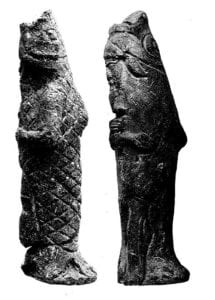The recent movie The Shape of Water won the Academy Award for best picture this past weekend. Like most of the country, I wasn’t watching. However, it appears I’m going to have to see it. Its plotline sounds a little too familiar.
In case you’re not familiar with the film, it’s about a captured amphibious fish-man (think creature from the black lagoon and you’ve got it). You can read the plot at the Wikipedia link, but basically the fish guy and a mute woman who loves him have sex and escape the government bad guys and live happily ever after (she grows gills in the end after fish-man heals her with his powers). We aren’t told if they have hybrid children together (maybe that’s the sequel — I can already see “Man from Atlantis” re-runs in mind’s eye).
I couldn’t help being reminded of the Mesopotamian apkallu tradition, where wise and powerful divine “sages” (apkallu) — sometimes described as being fish-like in appearance since they were born in the Apsu (“great deep” / Abyss) — mate with human women before the flood and thereby preserve the fantastic knowledge that would lead to the greatness of Babylon and other Mesopotamian cities after the flood. After the flood the apkallu are described as “of human descent” and (of course) giants (e.g., Gilgamesh). Figurines of apkallu buried in building foundations were called maṣṣarē in Akkadian (“Watchers”). Sound familiar?
From Black’s Gods, Demons, and Symbols of Ancient Mesopotamia (p. 18):
| Neo-Assyrian figurines of the so-called fish-garbed figures, representing the Seven Sages (apkallu) in the guise of fish. Sun-dried clay. (left) One of a group of seven figurines found together in a brick box buried in the foundations of the house of a priestly family at Aššur, probably dating to the reign of King Sargon it (721-705 BC). |  |
Black’s entry on the “Seven Sages” (pp. 163-164) adds this:
According to Babylonian tradition, seven apkallu (`wise men’ or `sages’) lived before the Flood. Neo-Babylonian and Neo-Assyrian ritual texts give their names and the seven cities from which they were believed to have come, although there are variant traditions which cannot be fully reconciled one with another. . . . The tradition of the Seven Sages seems to be preserved in Berossos’ account of eight creatures who appeared from the sea in the ‘first days’, beginning with Oannes and ending with Odakon.”
The apkallu story is the Mesopotamian backstory for Gen 6:1-4. This is virtually unknown to biblical students (even scholars) since prior to 2010 only two articles ever mention the apkallu in connection with that biblical passage. That all changed in 2010 with the excellent work of Amar Annus (as I have blogged before). Consequently, there’s a whole lot more to the apkallu than these brief comments. I wrote about them and Gen 6:1-4 in Reversing Hermon. Do I think director Guillermo del Toro is intentionally trying to “communicate” the apkallu / Gen 6:1-4? No. I doubt he’s been reading Mesopotamian material. But perhaps he had a muse.




